This is an AI-generated podcast-style chat about this article that does a surprisingly good job of covering the topic (mentioning this as I want to be transparent about any use of AI). Hardcore genealogists who want details, links, and so forth will be better off reading the article, but I wanted to offer this option for those who prefer podcasts. Feedback welcome!
Audio Player
How a Solitary Tombstone in Wisconsin Solved the Mystery of His Irish Origins
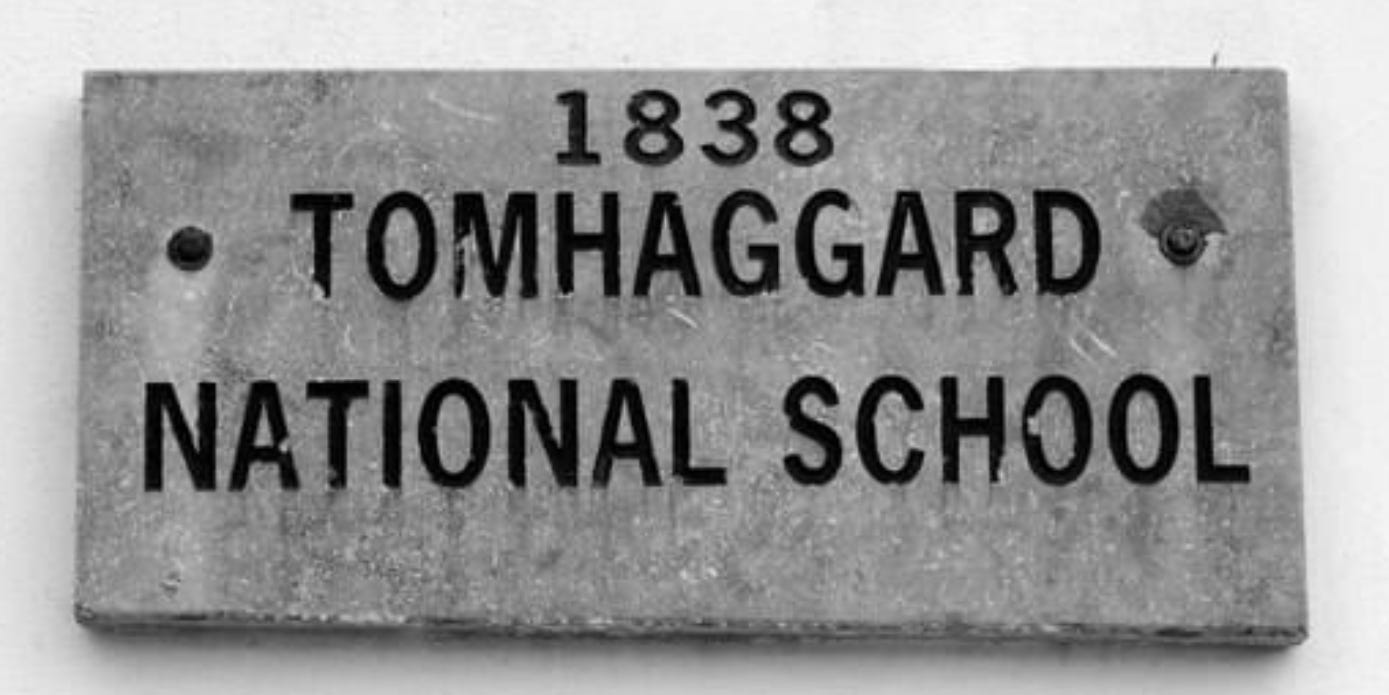
As a professional genealogist of half-Irish heritage, I’ve long embraced the opportunity to underscore the ties between Ireland and the United States, and one of the most obvious ways to do this is to trace the roots of high profile Americans to their place of origin in Ireland. This is trickier than it sounds since “crossing the pond” to Ireland can be challenging, especially when ancestors arrived Famine era or earlier. But I can be stubborn, so over the years have ferreted out Moneygall for then-first-time candidate Barack Obama, Ballina and Carlingford for then-Vice President Joe Biden, Rathangan for Bruce Springsteen, Limerick for Barry Manilow, Eyrecourt for Katy Perry, and so forth.
So it’s no surprise that I would do this again for Vice Presidential candidate Tim Walz. In this instance, I identified the Catholic parish of Kilmore in County Wexford, but came up short on naming the specific townland. No worries. Whenever I’ve done this in the past, genealogists in Ireland have piggybacked off my research to learn more about the individual’s past, so I figured it was just a matter of time.
The flurry of media coverage that said this was already happening only reinforced my expectation, but five weeks have gone by with no further word, so I decided to jump back in. This time around, I managed to zero in on a village called Tomhaggard, and I’m going to spend the balance of this article explaining how.
I’ll warn you now that this will probably provide more detail than many would be interested in, so if that’s you, feel free to stop reading here since you already have your answer. But if you’re a fellow geek or perhaps a skeptic, get comfortable as I park you on my shoulder to follow the process.
Surround and Conquer
Whenever you’re stuck genealogically, it’s always a good idea to find others associated with the people you’re researching, as it’s possible that they left the paper trail you wish your direct targets had. I casually refer to this as “surround and conquer,” although “cluster research” and FAN club (FAN = Friends, Associates, and Neighbors) are more popular terms.
In my earlier research, I had focused on immigrant James Sullivan and his parents, Daniel and Ellen (Doyle) Sullivan. All of them came to America in the latter half of the 1850s. James was one of five children born to the Sullivans, so I opted to start by seeking out the godparents of these children. Godparents are often relatives and a good first guess is siblings of the parents of the child being christened.
I could have gone about this several ways, but was fortunate to be able to take a shortcut thanks to a woman named Rachel Darlington who established and maintains a website called “Kilmore Genealogy.” The Internet used to host countless location-specific sites like this, but they’re becoming increasingly rare. Still, it’s always worth a look, and I’m so glad I did because Rachel has single-handedly transcribed civil, parish, and other records for the vicinity of Kilmore. Better yet, she did so more comprehensively than other resources as she troubled to include the names of wedding witnesses and baptism sponsors. This allowed me to search a single page, rather than perform a series of individual searches elsewhere.
I swiftly developed a list of godparents, and it jumped out that there were no Sullivans, but four Doyles – Judy, John, Catherine, and Denis. A look into other godparents hinted that they might have married into the Doyle family. This told me that James and Ellen Sullivan lived where her family – the Doyles – had come from, not his. There was a smattering of entries for Sullivans, but they were sparse on the ground – especially for such a common name – so I suspect that James was an incomer, at least from another pocket of Wexford.
Pushing Back
I also noticed from Rachel’s site that there were some earlier transcriptions of marriages and baptisms from 1798 to 1812. This was lucky since Catholic parish records are patchy and even more so this early, and I wondered whether I might be able to get back another generation. I knew from my previous research that Ellen (Doyle) Sullivan had supposedly been born in 1813 (according to her obituary), but the collection of documents I had for her suggested a range of 1810 to 1813.
With this in mind, I took a dive to see whether this batch that ended in 1812 might just include her and found an entry that looked promising. If this was her, then her parents were William Doyle and Catharine Moran. My next step was to search FindMyPast for any other children this couple might have had, and there they were – Judy, John, and Catherine – almost a perfect match for the names of those who would become godparents to Ellen’s children in later years. As to Denis, his birth was included and his parents were also a Doyle and Moran couple, so he was likely a first cousin. Yes, this was Ellen’s family.

17 February 1810 Marriage of William Doyle and Catharine Moran (Catholic Parish Registers at the National Library of Ireland)
Map Time
This is when I caught a break. The records I had searched over a month ago had no place names, but the priest who logged these earlier family events had kindly included the townland of the participants. I sought out each of the four baptisms as well as the marriage of the parents and pieced together the geography. The parents were living in Crossscales (yes, a triple ‘s’) when they married in 1810, had moved to Pludboher by the time of the birth of their first child, and then shifted once more to Grayrobin for the births of their next three children.
In an attempt to make sense of this, I turned to an incredibly helpful website by renowned Irish genealogist, John Grenham. One of the reasons determining an exact location in Ireland can be confusing is due to the variety of land divisions, and just for fun, they frequently share names and overlap, but have different boundaries.
I knew from my previous sleuthing that Tim Walz’s family was from the Catholic parish of Kilmore within the diocese of Ferns, but now in my effort to single out the correct townland, I had turned up three. John’s site offers the perfect tool for this kind of situation – one which overlays the maps of Catholic and civil (that is, government) parishes.
If you’re able, I’m going to request that you go to his Kilmore parish map and zoom into the bottom where you see Kilmore. Once you’re there, move the slider to the left to see the Catholic parish of Kilmore. If you look directly east from the lower “Kilmore” label, you’ll trip across Pludboher, and just above are Grayrobin and Crossscales. Now I had confirmation that this trio of townlands is indeed located within the Catholic parish of Kilmore.
But what about the civil parish? Shift that same slider to the right and you’ll get the view below. This grouping of townlands is associated with the village of Tomhaggard.
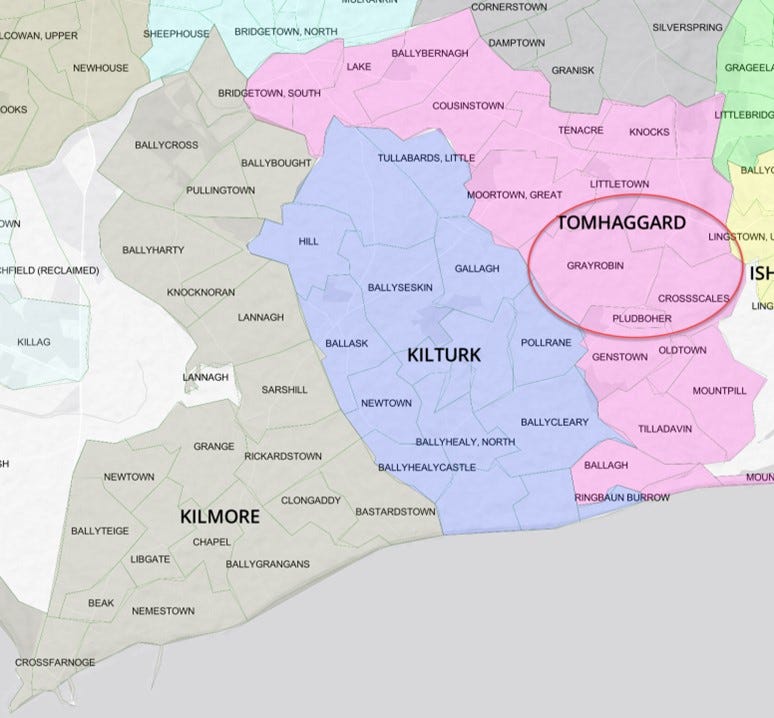
Wexford Catholic and Civil parishes overlaid (Irish Ancestors by John Grenham with maps created using © Mapbox and © OpenStreetMap)
Context Matters
At this point, I took a bit of a detour to poke around a tremendous Irish resource, The Dúchas Project, also known as the National Folklore Collection UCD Digitization Project. One of my favorite aspects of this is The Schools’ Collection which former school teacher, Tim Walz, would probably appreciate.
Back in the 1930s, students were instructed to write essays about the places where they lived. To do so, many spoke with elders in their communities and recorded stories and traditions that had been passed down, song and poem lyrics, and historical and geographical details. I’ve found it a useful way to get a feel for a place in Ireland that’s new to me.
Much to my delight, it holds a collection of essays for a school in Tomhaggard, and as I read through them (prepare to be dazzled by the exquisite penmanship if you explore), I began to understand both how intermingled and modest in scale they were. Eamonn Carty of Crossscales (then spelled by some as Crossgales), for example, wrote of the 25 people from seven families who lived there. The Doyle name popped up from time to time, as did multiple mentions of Father Mayler, a priest who was murdered there in 1653 (Cromwellian time frame), and “mass paths” which according to student Phyllis Codd were initially “used by our ancestors to bring corpses to the graveyards” before evolving into current day short cuts.

Essay by Phyllis Codd, “The Schools’ Collection, Volume 0621, Page 413” by Dúchas © National Folklore Collection, UCD is licensed under CC BY-NC 4.0.
Someone had even sketched out a map which includes the location of the priest’s martyrdom, a spot where a contemporary blog informed me, mass still takes place early on Christmas morning.
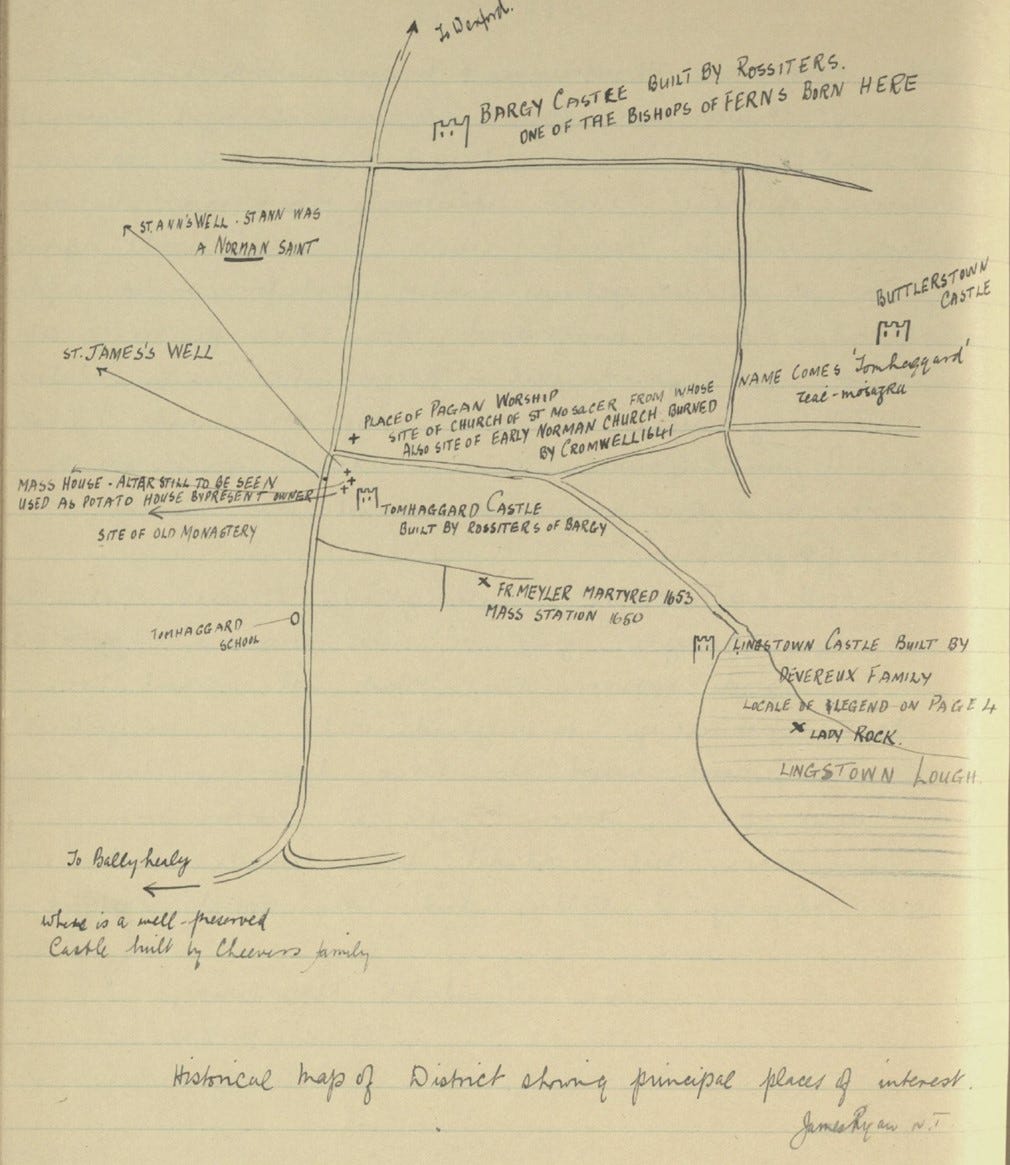
Tomhaggard map by James Ryan, “The Schools’ Collection, Volume 0621, Page 413” by Dúchas © National Folklore Collection, UCD is licensed under CC BY-NC 4.0.
Final Lap
Between the maps and the students’ essays, I realized that Tomhaggard was the family’s place of origin, but there was still one catch. I had proof that they had been there up through 1820 when that cluster of Doyle children had been born, but the more recent records didn’t have any place names. Had they stayed there until emigrating in the 1850s?

Obituary of Ellen (Doyle) Sullivan, Cedar County News, 28 December 1899 (Newspapers)
This is when I decided to revisit the Stateside research I had done before, starting with Ellen’s obituary. When I reread it, I remembered that I hadn’t followed up on the son named John. He hadn’t shown up in baptism records, so I didn’t know much about him. John Sullivan is a common name, but this at least told me that he had died in Wisconsin sometime before 1899.
Other records for the family that made fleeting reference to Wisconsin mentioned Madison in Dane County, so that’s where I looked, and that’s when I found a tombstone. The name, location, and timing all fit, and while it takes a little squinting, you can just make out that the text at the bottom says he was a native of “Thomhaggard.” I now had the substantiation I needed from both sides of the Atlantic, and yes, the family had remained there until the time of departure.
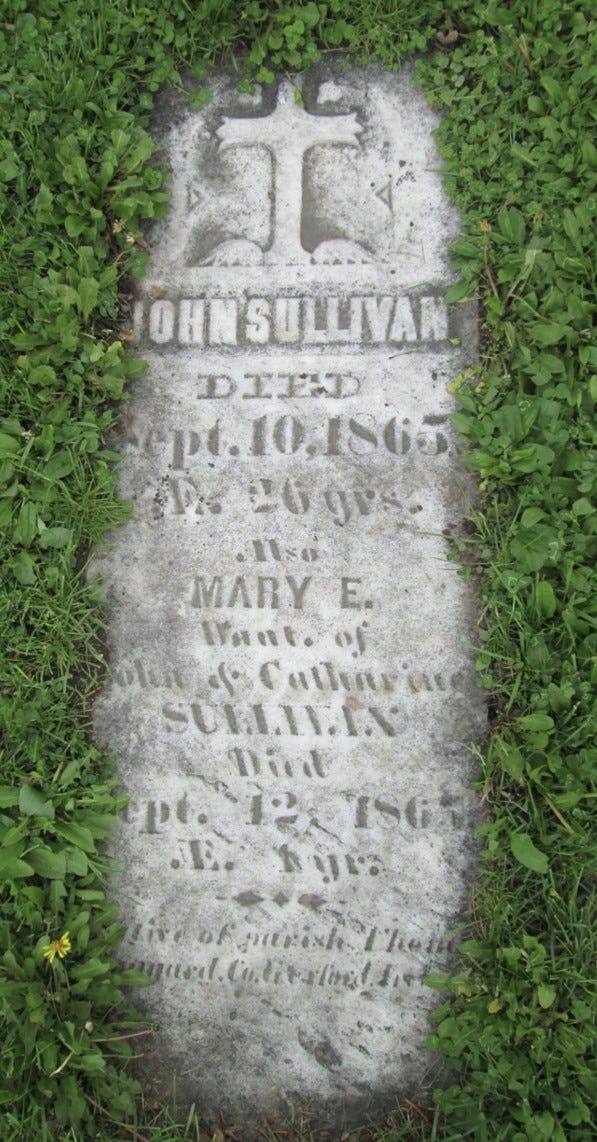
Tombstone of John Sullivan (FindaGrave, memorial by Angela Owens Jando and photo by Jade)
Flashback
At this moment, I experienced déjà vu, mentally flying back to early 2007 when I had traced Barack Obama’s roots to Moneygall. Just as with Tim Walz’s Irish immigrant ancestors, multiple generations of the family had come to the United States and settled in one place, only to move on to another. Both families had lost one or two relatives in their first American home with the result being that their tombstones were effectively stranded since they were in places that drifted out of descendants’ memory. And both of these isolated tombstones held the critical clue of the place of origin in Ireland. With Barack Obama, the missing puzzle piece resided in southeastern Ohio, and with Tim Walz in Wisconsin. From this genealogist’s perspective, it feels like lightning striking twice.
So it’s Tomhaggard, a historic village about 2.5 miles as the crow flies from Kilmore (though further by road), that was home to Tim Walz’s Doyle family. As it happens, before he was selected by Kamala Harris as her running mate, he was scheduled to lead a Minnesota trade mission to Ireland in November. A few things have changed since then, but let’s hope he has the chance to walk in his ancestors’ footsteps – perhaps along an old mass path – before long.

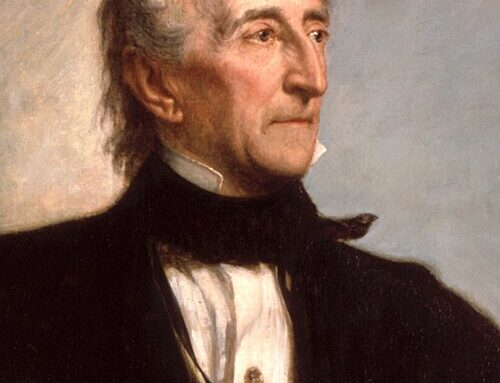
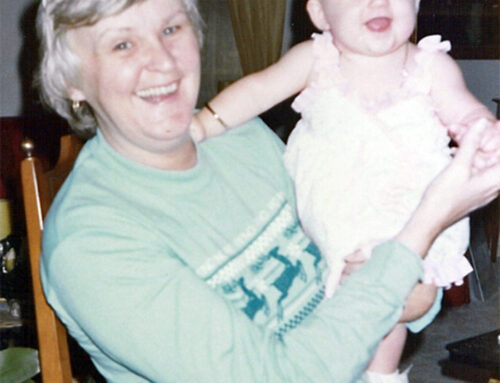

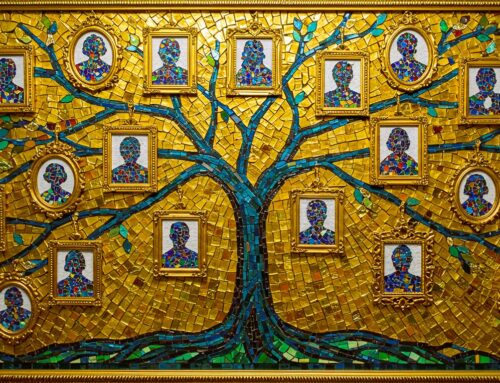
Leave A Comment